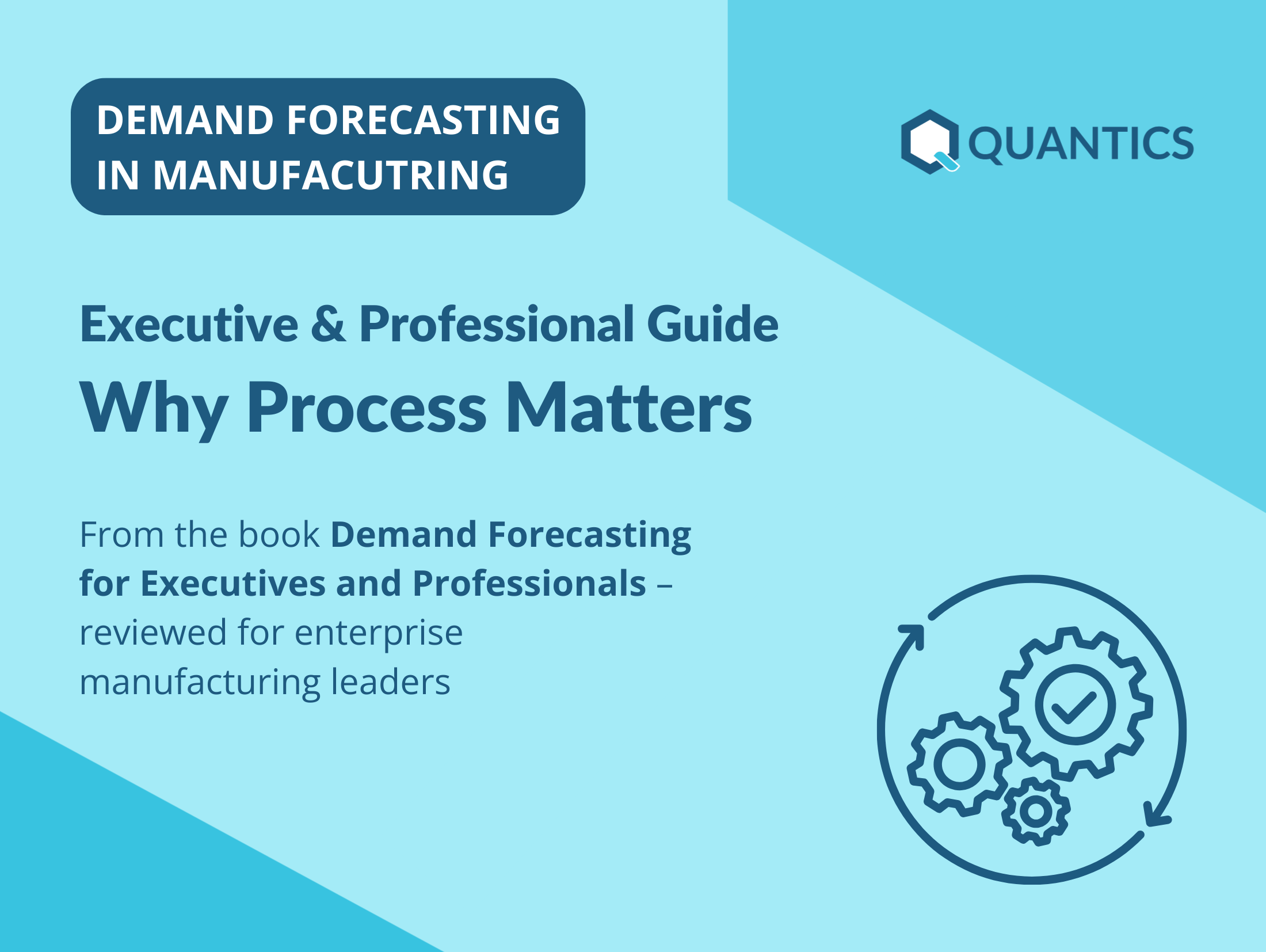Quick Guide: 7 steps to find the optimal demand planning tool
How do you choose the perfect demand planning solution and what should you look for when doing so? We provide you with 7 simple steps.

In a market environment that is becoming increasingly complex and volatile, demand planning software can help enormously. But how do you choose the perfect demand planning solution and what should you look for when making your selection?
In the post below, we provide you with 7 simple steps to help you find your perfect demand planning solution. Let's get started!
1. Becoming aware of the importance of demand planning.
Demand planning is a fundamental basis for important decisions along the supply chain. In production, for example, inaccurate demand planning can lead to unplanned spikes in demand. This results in additional costs and promotes delays. Particularly in core processes such as replenishment or transportation of products, inaccurate demand planning usually means excessive inventories, high capital commitment or redistribution costs, especially when products are not available in the right place and at the right time.
Inaccurate demand planning affects not only production, purchasing and logistics, but also financial planning. Incorrect forecasts can lead to financial resources being used ineffectively, causing important investments to be postponed and capital being tied up.
As a first step, it is therefore important to understand which areas are affected by demand planning and what the long-term consequences might be.
2. Understanding your own planning process
Now that you know the consequences of inaccurate demand planning, the next step is to understand your own planning process.
The following questions might help to guide you:
What does the current planning process look like?
Demand planning processes can be extremely complicated if they involve many manual sub-processes. So, before you start searching for a demand planning tool, you should define which steps need a substantial amount of time and what can be automated. This is especially the case when large amounts of data must be analysed, or individual forecasting models have to be created manually.
How good are the current forecast models?
Testing your own forecasting models is vital. For this, it is essential to be honest and approach the whole exercise objectively. Some disciplines feel attacked when more innovative solutions have a better approach and deliver more accurate results than existing methods. You need to realize that innovative solutions, especially those that specialize in demand planning and forecasting, are more likely to deliver better results. In this regard, it is highly recommended to create an internal benchmark and test it as part of a proof-of-concept.
Other questions you might want to ask yourself are as follows:
- Is the current demand planning process fit for the future?
- What are the costs?
- How long does a demand planning cycle take?
- How many people are involved?
- How error-prone is the current planning process?
- What might the planning process look like if a more innovative tool was available?
3. Define important selection criteria for the perfect demand planning tool
Before starting the search, it is important to define what an ideal demand planning tool looks like. Clearly, there are many criteria that can be used to evaluate tools. Therefore, it is essential to decide which criteria are relevant for your own company.
We have summarized the 5 main criteria for you:
High level of automation
Really good demand planning solutions facilitate planning instead of making it more difficult. Automation is something many can do, but not everyone defines automation in the same way.
The highest level of automation implies the creation of an individual forecast model for each product and the adaptation of this model if, for example, there are fluctuations.
To plan more efficiently, it is necessary to avoid time-consuming data preparation or the manual adjustment of forecast models. The ideal scenario would be that the planning tool performs the analysis of large amounts of data and the forecast model creation by itself.
Flexibility in respect of change
In a market environment that is continuously in motion, flexibility plays a key. An agile demand planning solution recognizes changes in data as well as in its environment and adapts accordingly.
A static solution, in contrast, needs to be manually adapted when it comes to changes and is no longer suitable for today's market complexity. In the long term, less agile demand planning tools tend to cause additional costs due to modifications.
Automatic detection of relevant internal and external data
In a data-driven world, it is important to understand what data impacts demand. Ideally, a demand planning software should automatically detect causalities and incorporate them into the forecasting process. To do so it is necessary that internal data can be easily imported into the demand planning system and the system provides its own large pool of external data. This eliminates the need to search for data manually, analyse it and prepare it for the forecasting process.
Integrability into the existing IT landscape
Modern demand planning solutions should be able to be integrated swiftly into the existing IT landscape. In this way implementation costs are kept low and results can be easily used in systems that are already in place. As a result, training efforts are kept to a minimum, so that results can be achieved immediately and key users can simply continue to work in their regular tools.
Room for improvement in forecast accuracy
A system that does not learn from past mistakes cannot improve in the long run. Special demand planning systems are self-learning and automatically fine-tune their forecasting models. This allows the best possible forecasting accuracy to be achieved. In addition, such systems offer the possibility of incorporating expert know-how to use it in different forecast scenarios. This enables the possibility to create a score for the inputs, so that poor inputs are given a lower weighting in the next forecasting run.
4. Set a rough budget for the demand planning solution
Prices for demand planning solutions can range widely. That's why it's helpful to be clear in advance what your company wants to spend in the first place. A budget for a demand planning tool should include at least the following cost items:
- Services to create the data basis for a proof-of-concept (PoC)
- Execution of a proof-of-concept (PoC)
- Necessary adaptations to the corresponding use case
- Roll-out and management
- Annual costs for the use case
Once a budget has been defined, it is much easier to find the appropriate vendor, as you don't fall into the trap of spending more than you wanted to in the end.
Before finalizing the budget, it is worth identifying potential savings as part of a proof-of-concept. This is the only way to really determine whether the investment in a demand planning software is profitable.
5. Defining the ideal partner: Innovative start-ups vs. established vendors
Before choosing a demand planning software, you must first understand which partner fits to your company. Be prepared to be spoilt for choice between large established vendors which can do a bit of everything and smaller companies that are particularly innovative in a certain field.
Start-ups typically follow an innovative approach and are quite flexible when it comes to customizations and requirements. In addition, they are in most cases cheaper and faster compared to large providers. On top of that, you definitely get innovation with start-ups, since otherwise they wouldn't be a start-up.
Established vendors are characterized by broad capabilities, which, however, take their toll. Broad solutions are all-rounders. In other words, they offer something for every use case without being truly excellent in one field. Furthermore, large vendors usually charge high implementation costs and are also significantly more expensive when it comes to annual usage fees.
Start-ups and established vendors have pros and cons that need to be weighed when you're trying to find the ideal demand planning partner. One thing is clear. You should pick the one which provides better results.
6. Vendor evaluation
After you have browsed the internet for providers, the time has finally come. This next step is the evaluation.
The goal of the evaluation is to clarify all open questions and communicate current challenges in demand planning. This allows the provider to elaborate on the issues and explain how and if they can be solved by their demand planning tool.
Below you will find some important questions that should be clarified in this step:
- Are the requirement criteria met?
- How innovative is the vendor and the product?
- What are the advantages?
- How easy is the demand planning solution to integrate into existing systems?
- What could be the possible potentials?
- What knowledge is required to use the solution?
- How long does the implementation take?
- Is there a possibility for a testing period?
- What data is needed for an initial test?
- Is the solution within budget?
- What are the next steps?
Once the most important questions have been answered, the next step is to create the necessary basis for an initial test.
7. Creating the foundation for innovative demand planning
After all the main questions have been clarified, the only remaining step is to create the basis for the proof of concept (PoC). Since you want to find out as quickly as possible which potentials are hidden behind the solution, it is important to define the scope. This allows you to test how well the respective demand planning software performs and what advantages it brings in comparison to the existing planning approach.
To create the optimal basis, it will be necessary to clearly define which data is required and in which format it must be made available. Additionally, it is essential to determine contact persons who can provide support in case of questions. Once you have created the basis it is all about hte magic of the demand planning tool.
Regardless of what you end up choosing, it's important to let the results speak for themselves. Choosing and finding an innovative demand planning solution is not an easy task, but it is worth it. Accurate forecasts have a significant impact on value creation and bear great competitive advantages. Therefore, when selecting, emphasis should be placed on the core of such solutions.
Forecast accuracy. Automation level. Ease of use.
About Quantics
Quantics offers a best-in-class solution for supply chain planning, specifically designed for large manufacturing enterprises. The focus is on innovative, AI-driven forecasting and seamless, collaborative planning that connects teams and makes processes future-proof.
Learn more.
Start now
Let's talk about how you can use self-learning systems for your demand forecasting and planning.
Learn how Quantics contains unique features that can optimally support your manufacturing businesses in unlocking the power of cutting-edge forecasting and supply chain planning.

Frequently Asked Questions
Find answers to common questions about our solutions and how they benefit your operations.






